Review - Vortex Diamondback 12x50 Binoculars
Posted: 6 December 2016
Updated: 23 February 2017
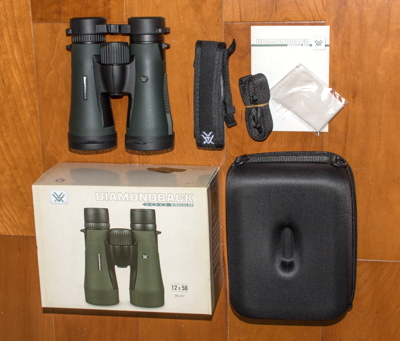
Diamondback 12x50 Binoculars
$319
Uni-Daptor
$40
Vortex Optics
I mentioned on my report of 29 October 2016 that I was going to replace my Celestron Cometron 12x70 Binoculars with a better pair. On Tuesday, 29 November 2016, while I was in Phoenix I went to the Cabela's store in Glendale, AZ. A friend who knows binoculars really well suggested checking their selection. And wow, did they have a selection of binoculars in all price ranges, sizes, and quality. I discussed what I wanted with the sales rep in the store, who really knew his products, and tested several binoculars. I had some requirements: magnification 10X or 12X, aperture 50mm or slightly greater, roof prisms, and lightweight. A tripod mounting capability was desired but not required. All of my previous binoculars had porro prisms (except for a pair of field glasses back in the early 1960s). Roof prisms would make the binoculars more compact and easier to hold. I finally decided on the Vortex Diamondback 12x50 Binoculars. The field-of-view is 4.6° with an exit pupil of 4.2mm (good enough for my old eyes). You can see complete specs on the Vortex web page.
The package contents are seen above right. It includes the binoculars, zippered semi-hard case, straps for the case and binoculars, lens cleaning cloth, and a small booklet of instructions. Here are three views of the binoculars:
Lens caps on
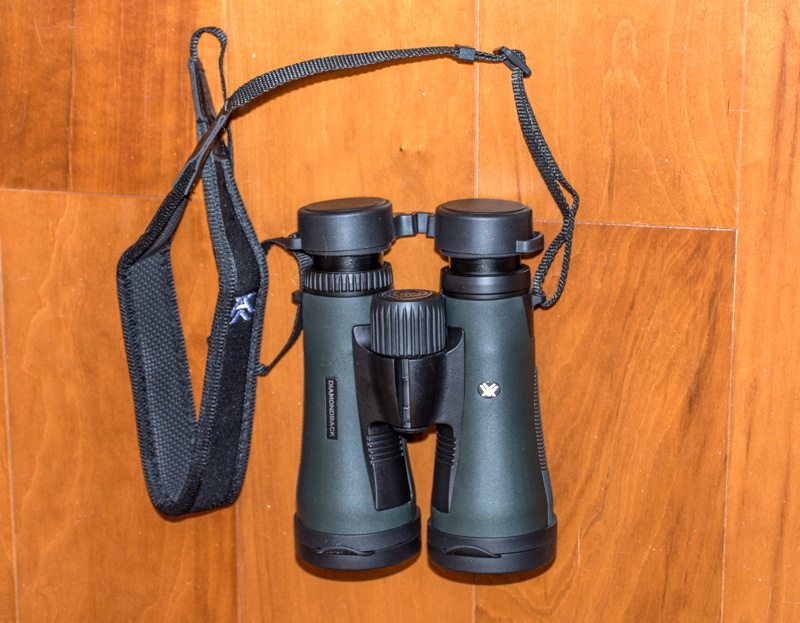 Lens caps off
Lens caps off
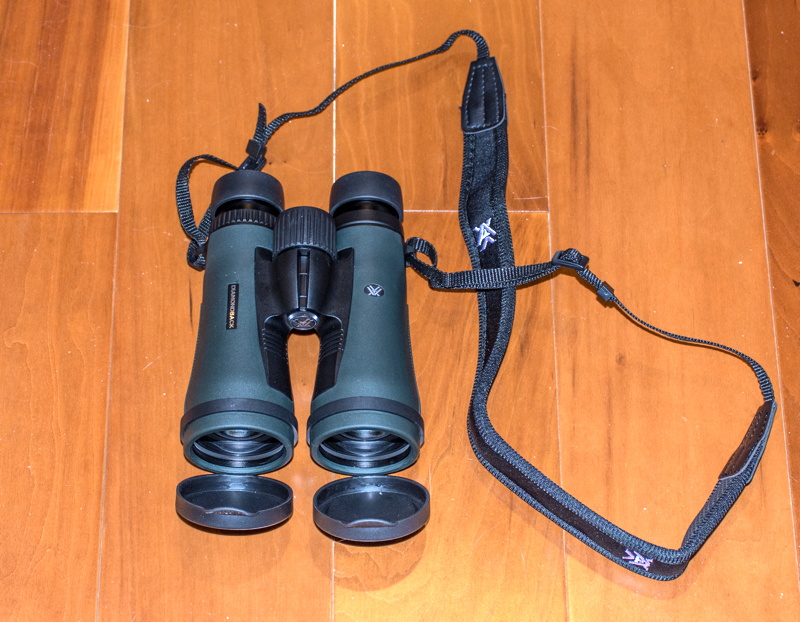
Aperture caps removed
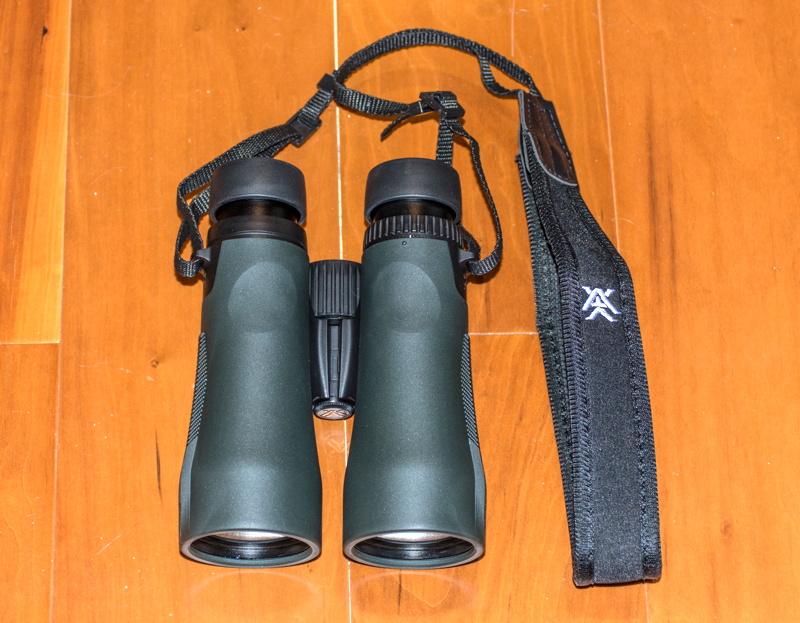
The binoculars have a large center-focus knob and the right eye ocular has a diopter adjustment. The oculars (eyepieces) can be adjusted for eye separation distance. The eyecups rotate to extend and retract. Eye relief is good for eyeglass wearers, providing nearly the full field-of-view. As seen in the middle photo above, the aperture lens covers are two-piece. They can remain attached to the binoculars or they can be entirely removed (bottom photo).
I did some brief terrestrial viewing during the daytime. Distant objects, mountains (31 miles away), and Kitt Peak National Observatory (65 miles away) were surprisingly nice. Of course, closer objects (minimum 9 feet) are also worthwhile targets for these 12x50 binoculars. The views were crisp and bright.
My first night use of the 12x50 binoculars was a joy. I viewed the Pleiades (Messier 45), the Hyades star cluster, the Double Cluster, the Andromeda Galaxy (M31) and its companion galaxies (M32, M110), the Great Globular Cluster in Hercules (M13), the planets Venus and Mars, and the Milky Way in the constellation of Cygnus. The Andromeda Galaxy extended across almost the entire field-of-view. Handheld, the view through the 12x50 binoculars was steady, even up towards the zenith. The view stayed nicely collimated with no collimation or focus changes while viewing (unlike with the Celestron 12x70 binoculars). Stars at the center were sharp. There was some distortion at the edge of the field-of-view. Overall, the views through the binoculars of astronomical objects were very good.
The binoculars have a tripod mount hole in-between the barrels. However, I discovered that my metal Orion binoculars tripod adapter would not fit in-between the barrels. My plastic Celestron adapter did fit between the barrels but just barely:
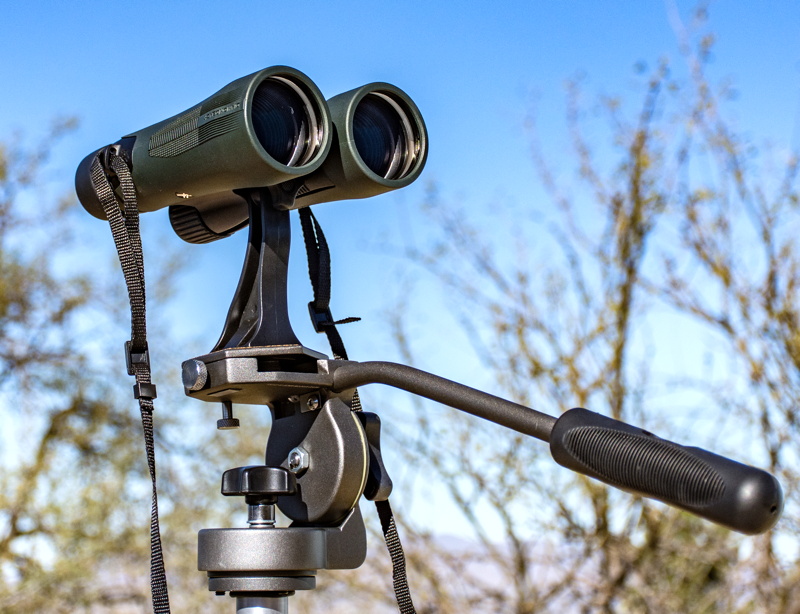
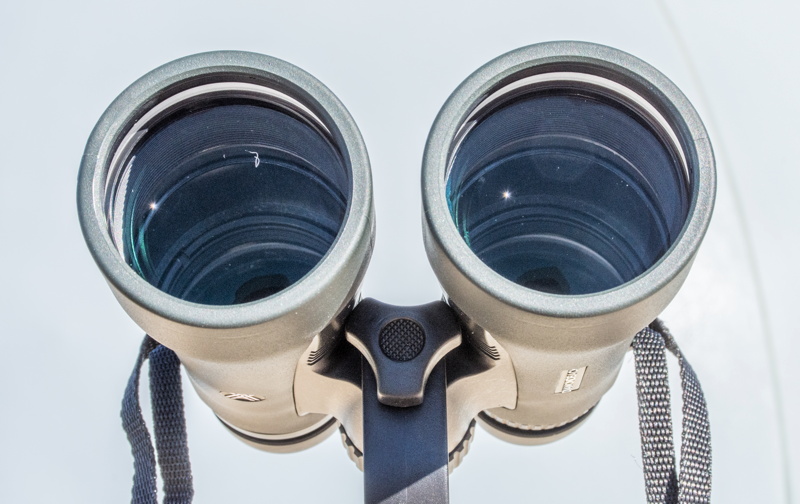
Note that I had to mount the binoculars upside down; that was the only way my Celestron adapter would fit on the binoculars. Vortex sells an adapter that fits better although I don't have one to test.
Using the proper adapter, a smartphone can be easily mounted to the Vortex binoculars for terrestrial photography:
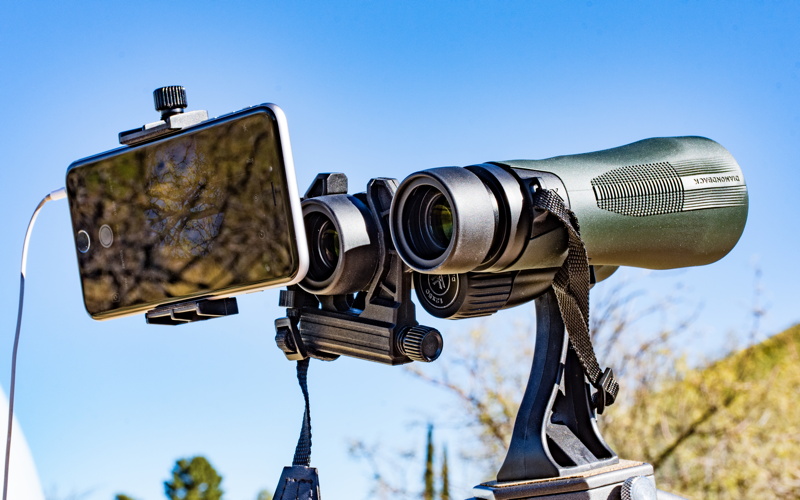
The above photo shows an iPhone 6s Plus mounted using a Levenhuk Smartphone Adapter. I used the Earbuds/Mic volume control as a remote shutter release for photos through one side of the 12x50 binoculars:
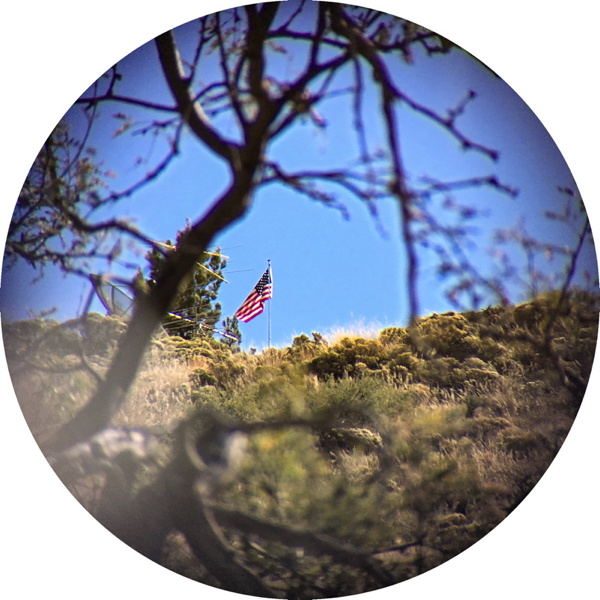
This is Kitt Peak National Observatory (65 miles away) at sunrise, showing several observatories on the mountain top:

You can also do some astrophotography with a smartphone. I used the iPhone with the iOS app NightCap Pro for this photo of the Pleiades (Messier 45) through the binoculars:
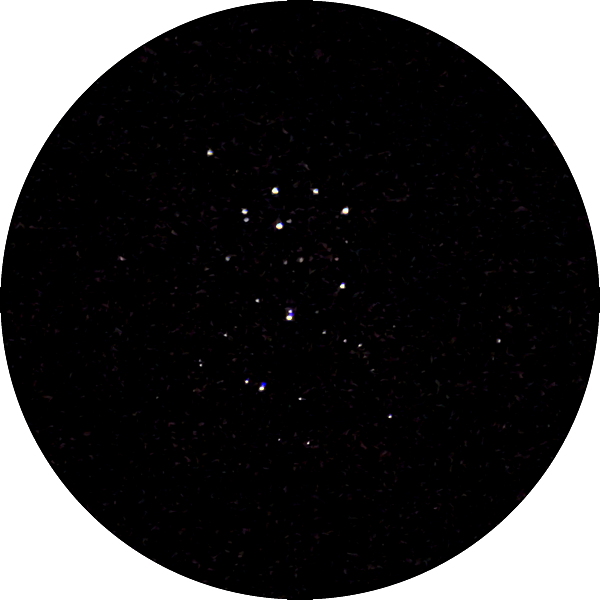
(The stars appear "bloated" due to the exposure used in NightCap Pro. The actual view was much sharper.)
And a photo of the crescent Moon in the 12x50 binoculars using the iOS Camera app:
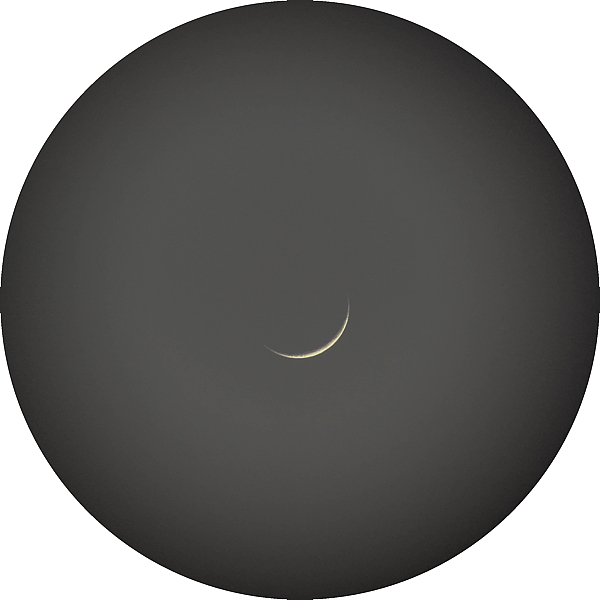

Attaching a smartphone converts binoculars into a "digital photography imaging system". I was thrilled to be able to do that with the Vortex 12x50 Binoculars.
Summary
The Vortex Diamondback 12x50 Binoculars have a solid feel in the hands. They are also easy to hold. I could even hold it steady with one hand. All adjustments (pupil separation, diopter, and eyecups) stay put unless you explicitly change them. The optics are very good, with just a slight distortion at the edge of the field-of-view. This distortion is not readily visible for terrestrial objects but will be seen with stars. It comes with a transferable Unlimited Lifetime Warranty: if the binoculars become damaged or defective, Vortex Optics will repair or replace it at no charge. As with the binoculars themselves, this warranty is impresssive. I look forward to viewing the splendors of the Universe from my dark sky site using the Vortex 12x50 Binoculars. You will too.
After using my Celestron binoculars tripod adapter with the Vortex 12x50 binoculars I decided that getting the adapter on and off the Vortex binoculars was more trouble than it should be due to the adapter size. I purchased the Vortex Uni-Daptor ($40), which I hoped would be a better match for these binoculars.
The Uni-Daptor came in a plastic bag with all the parts needed and printed installation instructions:
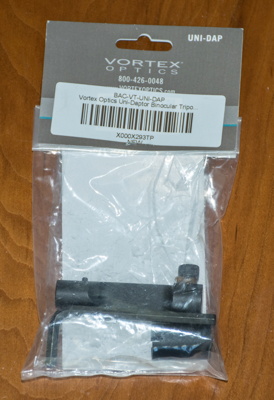
There are two ways to mount the binoculars to a tripod using the Uni-Daptor. You can mount the post directly on the tripod, as seen here:

Or you can mount the included quick release bracket on the tripod and then slide the adapter post into the bracket:

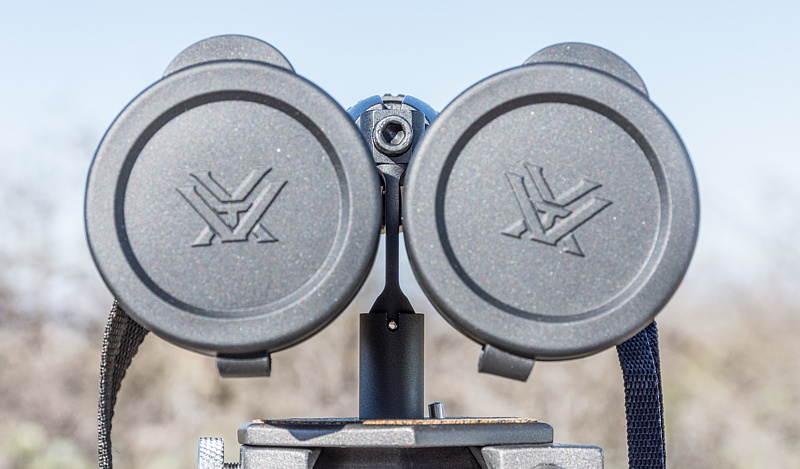
This versatility has definite advantages for astro (and terrestrial) viewing. If you intend to do long periods with the binoculars on one object, especially if you mount the binoculars on a sky tracker like the iOptron SkyTracker Pro, then mounting the binoculars directly will be best. On the other hand, if you prefer the ease of removing the binoculars from the tripod to locate other objects and then remounting the binoculars on the tripod for extended viewing, using the quick release bracket will be ideal.
The adapter is small and so can be left on the binoculars without hampering handheld use.
If you want to mount your Vortex 12x50 binoculars on a tripod, the Uni-Daptor is the best choice to do that.
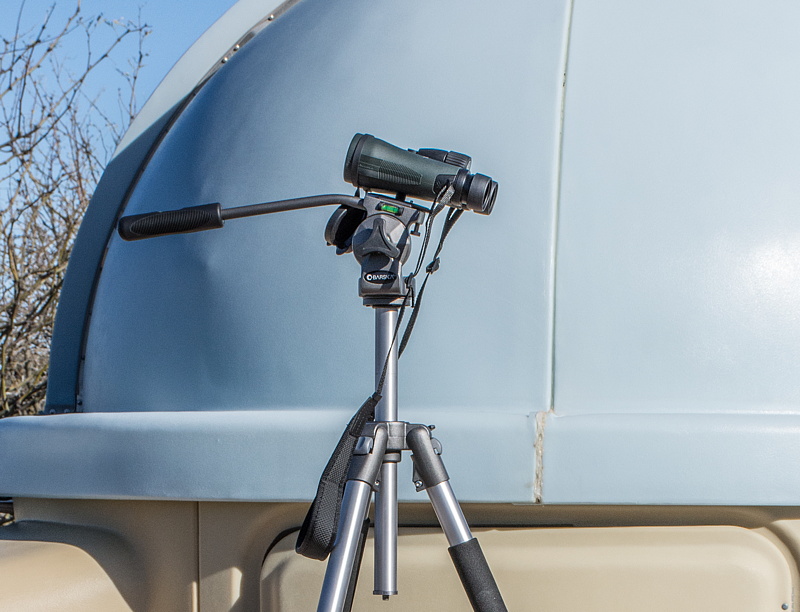
Comments are welcome using Email. If you are on Twitter you can use the button below to tweet this review to your followers. Thanks.
Cassiopeia Observatory Home Page
Copyright ©2016-17 Michael L. Weasner / mweasner@me.com
URL = http://www.weasner.com/co/Reviews/2016/Vortex_12x50_Binoculars/index.html
